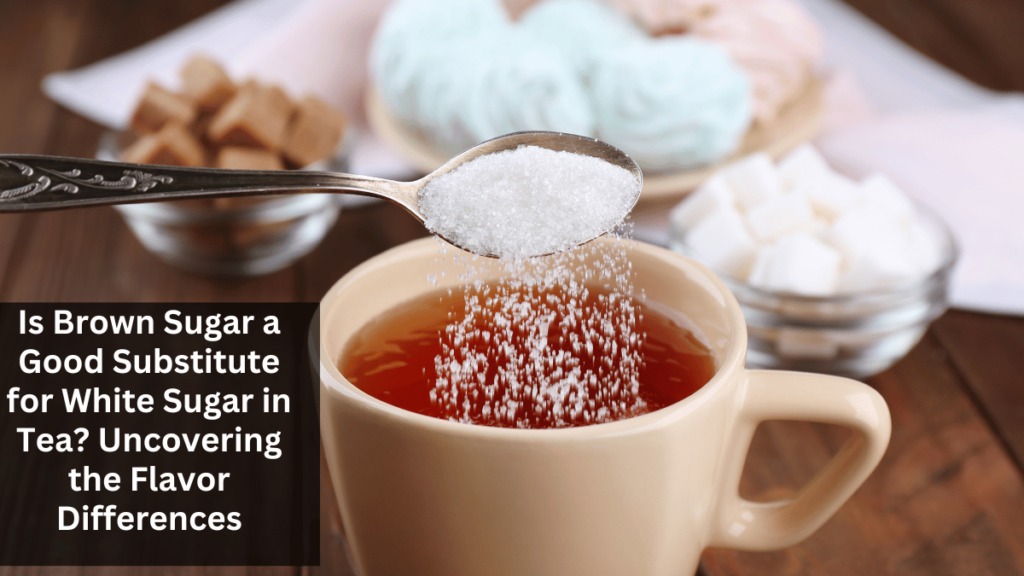Brown sugar is essentially white sugar with added molasses, which gives it a richer and more complex flavor. Unlike white sugar, which is pure sucrose, brown sugar retains small amounts of minerals like calcium, potassium, iron, and magnesium from the molasses. This difference in composition also affects how brown sugar interacts with other ingredients in your tea.
The Impact on Flavor: Brown Sugar vs. White Sugar
The choice between brown and white sugar can significantly influence the taste of sweetening tea. Brown sugar adds a deeper, more caramel-like flavor to the tea, which can enhance certain varieties, such as black or chai tea. The molasses in brown sugar provides a subtle warmth and richness that complements the boldness of these teas. On the other hand, white sugar offers a clean, neutral sweetness that doesn’t alter the tea’s original flavor profile, making it a versatile option for any tea type.
Texture and Sweetness Levels: What to Expect
Brown sugar is typically moister than white sugar, affecting tea’s dissolving rate. While white sugar dissolves quickly, providing immediate sweetness, brown sugar may take longer to integrate fully into your beverage. This slower dissolving process can result in a more gradual release of sweetness, allowing the tea’s flavors to evolve as you sip. In terms of sweetness, brown sugar has a slightly lower sucrose content per gram than white sugar, so you might need to use more brown sugar to achieve the same level of sweetness.
Nutritional Differences: Is Brown Sugar Healthier?
From a nutritional standpoint, brown sugar contains trace amounts of minerals due to the molasses that white sugar lacks. However, these amounts are minimal and contribute little to your daily nutritional intake. Both brown and white sugars have similar calorie counts, with one teaspoon of brown sugar containing about 17 calories and the same amount of white sugar containing about 16 calories. Therefore, while brown sugar may offer a slightly richer flavor, it doesn’t provide a substantial health advantage over white sugar.
Environmental Impact: The Production of Brown vs. White Sugar
When assessing the environmental impact of sugar production, brown sugar may have a slight edge over white sugar. Since brown sugar requires less processing than white sugar, its production tends to have a lower carbon footprint. The refining process for white sugar involves additional steps to remove molasses, which can consume more energy and resources. For those conscious of their environmental impact, brown sugar might be more sustainable.
How Brown Sugar Affects Tea’s Aroma
Another aspect to consider is how brown sugar influences the aroma of your tea. The molasses content in brown sugar enhances the flavor and adds a warm, inviting scent to your tea. This aromatic quality can elevate the tea-drinking experience, particularly with aromatic teas like chai or Earl Grey. White sugar, being odorless, doesn’t contribute to the tea’s fragrance, making it a better choice if you prefer the natural aroma of the tea itself.
Cultural Preferences and Regional Uses
Cultural preferences often dictate the type of sugar used in tea. In some regions, brown sugar is the preferred sweetener for tea, especially in parts of Asia and the Caribbean, where the rich flavors of brown sugar are celebrated. In contrast, white sugar is more commonly used in Western countries, where it is favored for its consistency and neutrality. Exploring the cultural significance of sugar choices in tea can offer insights into how different societies appreciate their tea rituals.
Pairing Tea Varieties with Brown Sugar
Brown sugar pairs particularly well with robust tea varieties that can stand up to its rich, molasses-infused flavor. Black teas, such as Assam or Ceylon, and spiced teas, like chai, benefit from the added depth brown sugar provides. These teas already have firm flavor profiles, and the caramel notes of brown sugar can enhance their complexity. In contrast, more delicate teas like green or white tea might be overwhelmed by the intensity of brown sugar, making white sugar a better choice for these varieties.
Experimenting with Brown Sugar in Tea: Tips and Tricks
If you’re new to using brown sugar in tea, start with a small amount to gauge how it affects the flavor. You can gradually increase the quantity if you enjoy the richer taste.For a richer flavor experience, try using brown sugar, which has a higher molasses content. Alternatively, if you’re looking for a middle ground between the two sugars, try using a brown and white sugar blend to balance the sweetness and flavor intensity.
Conclusion: Which Sugar Should You Choose?
Ultimately, the choice between brown and white sugar in tea comes from personal preference. If you enjoy a richer, more complex flavor, brown sugar is an excellent option, especially for more robust teas. However, white sugar remains the classic choice if you prefer a purer sweetness that doesn’t alter the tea’s original taste. Both sugars have unique qualities, and experimenting with them can help you discover new and exciting ways to enjoy your favorite teas.
Data Insights: Popularity of Sugar Choices in Tea
Recent surveys indicate that approximately 60% of tea drinkers prefer white sugar for its neutrality and quick dissolving properties, while 25% enjoy the deeper flavor of brown sugar, especially in black and spiced teas. The remaining 15% opt for alternative sweeteners like honey, agave, or no sweetener at all, showcasing the diverse preferences among tea enthusiasts.



